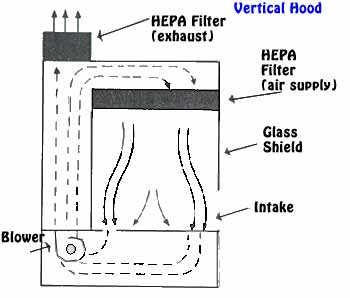Introduction |
| Attitude: Number one rule: always think of the patient. A well thought out training program for aseptic technique should focus on safety and accuracy. Safety: a.) The finished product should be free of contamination (particles, bacteria, extraneous material). b.) The solution should be clear — all medications should be completely dissolved. c.) All compounding materials should be checked for expiration date, outer integrity, etc. Accuracy: Guidelines must be set up to ensure the right drug, right dose, and right concentration. This includes using the appropriate syringe size to measure out fluid volumes in order to minimize errors. Another example would be to require that all syringes be drawn back to the original amount of each individual dose and placed next to the admixture to facilitate checking by the pharmacist. If a filter needle was required, it should also be present. Dangers of poor aseptic technique: |
Laminar Flow Hoods: |
| 1. Provide clean air to the working area.
2. Provide a constant flow of air out of the work area to prevent room air from entering. 3. The air flowing out from the hood suspends and removes contaminants introduced into the work area by personnel. The most important part of a laminar flow hood is a high efficiency bacteria-retentive filter. Room air is taken into the unit and passed through a pre-filter to remove gross contaminants (lint, dust etc). The air is then compressed and channeled up behind and through the HEPA filter (High Efficiency Particulate Air filter) in a laminar flow fashion–that is the purified air flows out over the entire work surface in parallel lines at a uniform velocity. The HEPA filter removes nearly all of the bacteria from the air. Why control room air? Limitations: With poor technique it is easy to overcome the established airflow velocity and introduce reverse currents that can re-introduce contaminants into the work area. Laminar hoods should remain on 24 hours a day. If turned off for any reason, it should be on for at least 30 minutes and thoroughly cleaned before reusing. Examples of vertical and horizontal laminar flow hoods:
|
Aseptic technique: guidelines & key points |
A direct path must be maintained between the filter and the area inside the hood where the manipulations are being performed. Air downstream from non-sterile objects (such as solution containers, hands etc.) becomes contaminated from particles blown off these objects. To best illustrate this very important point click on the two examples of proper aseptic technique: (manipulation of a vial and an ampoule).
The hands should never obstruct airflow around the area where the needle enters the vial or ampoule. Also, when pulling back the plunger of a syringe, the fingers should not come in contact with any part of the plunger–except the flat part at the end. Poor manipulation of the syringe is the most frequent cause of contamination. Always minimize clutter. Waste and other items should never enter the hood. All calculations should be done before entering the hood. Wash hands and arms before compounding or re-entering the hood. Also, remove any jewelry from the hands and wrists. It is important that you keep your hands within the cleaned area of the hood as much as possible. Do not touch your hair, face or clothing. Excess dust should be removed from items before introducing them into the hood. Arrange objects in a manner to get full benefit of the laminar flow of air. Critical items should be placed as close to the air source as possible. In a horizontal hood, items should be placed no closer than 3 inches from the very back of the hood (nothing should touch the filter). Occasionally, you may stack a few items (eg IVPB’s), however they must be stacked from lower to higher starting from the back of the hood. Also, it should be limited to a maximum of 3 to 4 items. When working in a horizontal laminar flow hood, all work must be performed at a distance of no less than 6 inches from the front edge of the work surface. At a distance of less than 6 inches, laminar flow air begins to mix with the outside air and contamination is possible. Never become so engrossed in your work that you forget this basic rule. Avoid spraying or squirting solutions onto the HEPA filter. Always aim away from the filter when opening ampoules or adjusting syringes. Outer pouches and wraps should be removed at the edge of the work area as the sterile contents are pulled into the work area. Never bring these items into the main work area. Large objects should never be placed near the back of the hood. Not only do these objects contaminate everything downstream, but they also disrupt the laminar flow pattern of air which normally suspends the contaminants and removes them from the area. Remember that hand cleanliness is further reduced each time more bottles and other non-sterile items are handled. Before and after preparing a series of IV admixtures, or anytime something is spilled, the work surface of the laminar flow hood should be thoroughly cleaned with alcohol. A long side to side motion should be used starting at the back of the hood and then working forward. The acrylic plastic sides should also be cleaned periodically. It is possible to overcome the established airflow velocity by a strong reverse current produced by coughing, quick movements, talking etc. Keep all of these to a minimum in order to maintain a sterile environment. Do not talk, cough or sneeze into the hood! The contents of glass ampoules should always be filtered before adding to an IV admixture. Needles should be used for a maximum of 8 to 10 punctures. It may be necessary to change the needle more frequently if it becomes increasingly difficult to enter a vial. Always disinfect all rubber stoppers and ampoule necks with alcohol before entering with a needle. |
References |
|
1. Dispensing of Medication (9th edition), Robert E. King, 1984, pg 176-177, 202.
2. Safe handling of cytotoxic drugs. ASHP Study Guide. 1986, pg. 3-23. 3. Sterility Testing of Antimicrobial-containing Injectable Solutions Prepared in the Pharmacy. Am J Hosp Pharm. 1991; 48: 2414-2417. 4. Training Manual for Intravenous Admixture Personnel. Max L. Hunt, 1989, Baxter Health Care Corp., pg. 1-117. |




